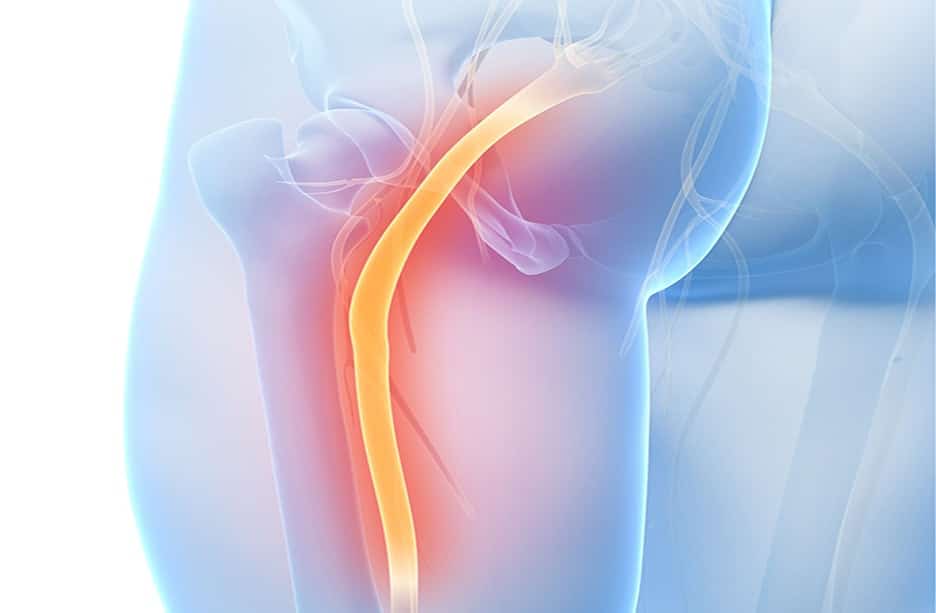Your sciatic nerve pain may be a dull aching on some days. On other days, sciatica is continuous, and severe, and has you hunting for relief everywhere.
Whatever the reason for your sciatica, it’s critical to understand how to manage your sciatic pain at home and when to seek medical attention.
Most people can get relief from sciatica without surgery by combining therapy.
In general, you should concentrate your efforts on your lower spine, buttocks, and hamstring muscles, as tightness or pressure in these areas may be causing or exacerbating your sciatica.
Below, are some tips on how to relieve sciatica pain.
Massage for sciatic pain
Massage is another method for relieving muscle tension and pain. Focus on your lower back, rear pelvis, and thigh when performing sciatica massage at home. However, try to avoid particularly painful areas because they may aggravate your sciatica. Heat can assist in loosening things up before a massage, while cold therapy can help relieve pain.
If you have a friend or family member who is ready to help, an ice massage can be a terrific approach to relieve back pain. Here’s how to go about it:
- To begin, freeze water in a paper cup.
- Remove the cup from the freezer and tear off the upper section of the cup, revealing ice on the top.
- As the ice melts, rub it into your back and thigh, ripping away more of the paper cup.
Oral anti-inflammatory medications
Before speaking with your doctor about prescription possibilities, it’s best to start with over-the-counter (OTC) options. Oral anti-inflammatory drugs can provide immediate pain relief.
Topical ointments, gels or creams
Topical lotions, ointments, and gels help alleviate pain and relax muscles that are producing discomfort. Even better, they begin to function immediately after you use them.
Most people find that these things help in some way.
How to sleep with sciatica
There is no one best sleeping position that works for everyone who suffers from sciatica, and finding a comfortable posture may take some time.
Sleeping on your side helps to adjust your hips and relieves pressure on your pelvic floor. Side sleeping can also assist in opening up the smaller regions in the spine if you have a spinal issue.
Laying back with your knees up relieves pressure on the lower back and spinal discs. However, it may not be the ideal option for everyone, particularly those with sleep apnea problems.
With sciatica, stomach sleeping might be difficult since you must arch your back and shift your head to the side. There’s no need to shift if you can sleep and wake up feeling rejuvenated after a night of stomach sleeping.
Prescription medications
To reduce pain, your sciatica specialist may prescribe a variety of oral drugs, including:
- Muscle relaxers – they can provide relief from painful muscular spasms.
- Norepinephrine modulators – These antidepressants can help you feel less pain, but they may take some time to act. They function by releasing molecules that suppress the pain signal.
- Anti-seizure medications – The drugs can relax your nerves, lessening the burning, stabbing, and shooting pain associated with sciatica. They work by suppressing pain signals.
- Controlled substance pain relievers – Opioid medicines can be an effective strategy to relieve pain in the short term. However, when you stop taking opioids, your pain usually worsens. Furthermore, they can be addicting. As a result, doctors typically reserve them for severe pain and only prescribe them for a limited duration.
Steroid injections for sciatica
A steroid injection in your lower back may be recommended by your doctor to relieve inflammation around the nerve root, which may be causing sciatic discomfort.
Steroid injections have transient effects, but they can relieve discomfort, enhance function, and set the stage for healing. You’ll be more comfortable practicing stretches and exercises that will help you heal if you’re not in pain.
If your pain returns, you won’t be able to get another steroid injection straight away because too many, too close together can cause more serious side effects.
Physical therapy exercises for sciatica
Physical therapy is a clinically proven method of relieving pain and increasing muscle strength. Physical treatment for sciatica typically lasts 6-12 weeks, with most people attending sessions 2-3 times per week. Here’s what to expect:
- Evaluation – Your physical therapist will most likely do specialized assessments such as strength and mobility testing. This allows them to establish the root cause of your pain, as well as examine your range of motion and mobility.
- Therapeutic exercises – Your physical therapist will employ a variety of treatments to treat the afflicted area and increase the strength and mobility of certain muscle groups.
- Education – Your physical therapist will teach you about the causes of your discomfort, the significance of being active, and how to exercise safely.
- Tailored exercise program – Your physical therapist will design a treatment plan for you that includes the finest stretches and exercises for you. They will also provide help to ensure that you complete them correctly.
However, as previously stated, the type of physical therapy program that is ideal for you will depend on several things, including how long you’ve been dealing with sciatic pain. If you have acute or short-term sciatic pain, you can begin with a normal physical therapy regimen.
A more specific spine strengthening program, such as the TRIA Neck and Back Strengthening Program, may be indicated for patients with chronic sciatic pain that lasts more than 12 weeks. TRIA’s spine strengthening program employs FDA-registered medical strengthening equipment that has been shown to help you improve your spinal fitness and reduce pain without surgery.
